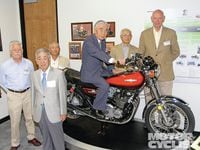Yoji Hamawaki leans across the table at a posh eatery near the current headquarters of Kawasaki Motors Corp. and says, “You know that we called the Z1 project ‘New York Steak,’ but do you know why?” The former Kawasaki Motors president doesn’t wait for a response. “We knew that in America the best meal on the menu was New York steak. In our minds, the Z1 was going to be the best motorcycle we could make, the top of the menu.” His eyes shine brightly as he remembers the time, 40 years ago, when small Kawasaki swallowed hard and swung for the fences.
“We already had a prototype of a 750cc four-stroke road bike,” Hamawaki recalls. He’s seated in a line of Kawasaki colleagues including Sadaichi Saito, former head of R&D, Yukio Otsuki, engineering lead, Sam Tanegashima, project leader, Alan Masek, general manager of the U.S. importer, and Bryon Farnsworth, factory test rider. They’re in Southern California for a celebration four decades after the Z1 debuted. “We had a big project, but then Honda introduced the CB750,” he continues,“and we knew we had to do something more. But there was a problem. We had a ‘gentleman’s agreement’ to keep [displacement] at 750cc or less.”
By limiting engine size, the Japanese manufacturers were trying to run under the radar of Harley-Davidson and the European manufacturers. To step outside that agreement, producing a large-displacement bike to take on the world, presented a frightening yet powerful possibility. Could they get over strong cultural inclinations to hold back? “There was a lot of debate,” Hamawaki says, “but we decided it was critical for our survival…to make the Z1.”
Kawasaki started over from the bones of the 750 project, took the engine as large as it would go. It turned out that a 66mm x 66mm configuration was compatible with the cases, whose castings had been set. Added up, the two-valve-per-cylinder engine displaced 903cc. “We had some information that Honda was working on a larger engine than the CB750’s,” recalls Alan Masek, “and we realized that this was our chance to leap frog. If we waited, did a 750 also, we might be beaten twice.”
“We had already decided on the double overhead cam layout,” says Hamawaki, “because its was proven in racing. Some [inside Kawasaki] objected to putting ‘DOHC’ on the engine, but it was important to say how advanced it was.”
Kawasaki’s management also knew that it was better known for explosive, sometimes fragile two-stroke engines. How do you prove the durability of your new design? Set a record. Kawasaki took to Daytona in the spring of 1973, claiming a 24-hour record of 109.641 mph with mostly stock bikes. One of those survivors lives in Kawasaki’s U.S. museum; the only obvious differences are Clubman bars and odd-looking Goodyear tires. “We had a lot of trouble with tires in early testing,” says Bryon Farnsworth. “Finally, Goodyear used the rubber compound from a NASCAR tire and we were fine.” The 24-hr. record beat the old one by almost 10 mph and was among 46 world and U.S. records set.
The Z1’s combination of speed and style—rakish and smooth where the CB750 was conservatively molded—was matched by proven endurance. It was a huge success for the company with a fifth of Honda’s production capacity; the last true offspring of the legendary Z1 engine was sold as recently as 2005 in the KZ1000P.
A half hour into lunch, the men gathered to remember the Z1 pause the conversation to enjoy a succulent New York steak and dare to show their pride in a gamble taken—and a delicious victory over Honda.












/cloudfront-us-east-1.images.arcpublishing.com/octane/TNOU5DNE2BC57MFPMGN2EIDXAM.jpg)
/cloudfront-us-east-1.images.arcpublishing.com/octane/GTCXACQGJ5HAPDTGWUQKDEH44E.jpg)
/cloudfront-us-east-1.images.arcpublishing.com/octane/S35YGSEMEZB4BLTDJTSZPF4GLA.jpg)
/cloudfront-us-east-1.images.arcpublishing.com/octane/5UOT6HPX2JFMRJAX6EH45AR4MQ.jpg)
/cloudfront-us-east-1.images.arcpublishing.com/octane/OKWOJWAKP5EP3OACCRRWPCIX2Q.jpg)
/cloudfront-us-east-1.images.arcpublishing.com/octane/2WF3SCE3NFBQXLDNJM7KMXA45E.jpg)
/cloudfront-us-east-1.images.arcpublishing.com/octane/G4MG6OUCJNBSHIS2MVVOTPX65E.jpg)
/cloudfront-us-east-1.images.arcpublishing.com/octane/IIGGWFOTOJGB7DB6DGBXCCMTDY.jpg)
/cloudfront-us-east-1.images.arcpublishing.com/octane/QSTCM6AVEZA5JJBUXNIQ3DSOF4.jpg)
/cloudfront-us-east-1.images.arcpublishing.com/octane/U4I7G625B5DMLF2DVIJDFZVV6M.jpg)
/cloudfront-us-east-1.images.arcpublishing.com/octane/B6XD6LS6IVCQPIU6HXDJSM3FHY.jpg)
/cloudfront-us-east-1.images.arcpublishing.com/octane/ICL63FEDDRDTTMINYICCEYGMDA.jpg)
/cloudfront-us-east-1.images.arcpublishing.com/octane/FCGZHQXRBZFLBAPC5SDIQLVF4I.jpg)
/cloudfront-us-east-1.images.arcpublishing.com/octane/WNOB6LDOIFFHJKPSVIWDYUGOPM.jpg)

/cloudfront-us-east-1.images.arcpublishing.com/octane/X33NU3E525ECRHXLNUJN2FTRKI.jpg)
/cloudfront-us-east-1.images.arcpublishing.com/octane/6KKT5NNL2JAVBOXMZYS5ZO76YA.jpg)
/cloudfront-us-east-1.images.arcpublishing.com/octane/J5RKG5O455GMPGQRF2OG6LRT7A.jpg)
/cloudfront-us-east-1.images.arcpublishing.com/octane/GX2CIZKQVRH2TATDM26KFG2DAE.jpg)
/cloudfront-us-east-1.images.arcpublishing.com/octane/ZWIDYSAKQZHD5BHREMQILXJCGM.jpg)
/cloudfront-us-east-1.images.arcpublishing.com/octane/CYUHJZCTSJCH3MRAQEIKXK7SCQ.jpg)
/cloudfront-us-east-1.images.arcpublishing.com/octane/LKOFINY56FCXJCANJ5M7ZDQUBY.jpg)
/cloudfront-us-east-1.images.arcpublishing.com/octane/4NBPDACMWJH63JQYJVK3QRBDZI.jpg)
/cloudfront-us-east-1.images.arcpublishing.com/octane/KKHQHRR3FJGX7H2IPU6RALMWG4.jpg)